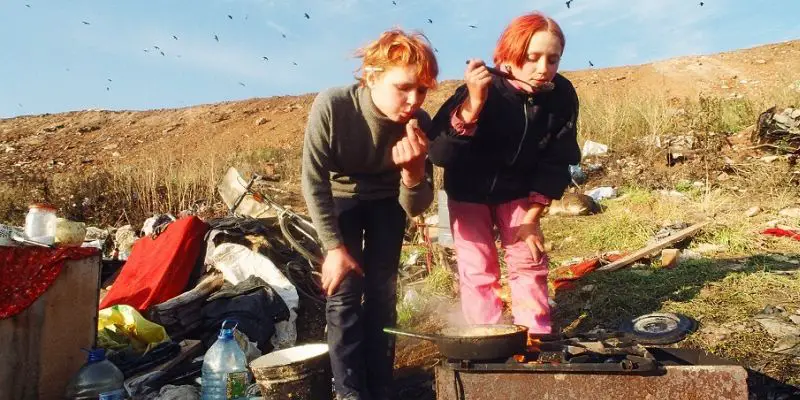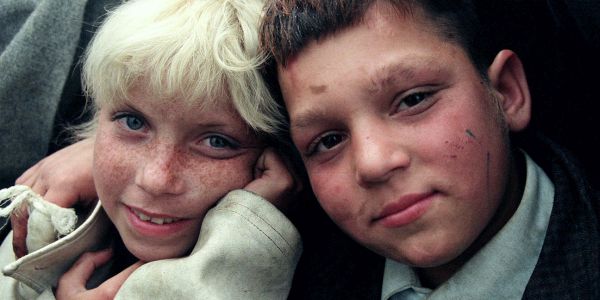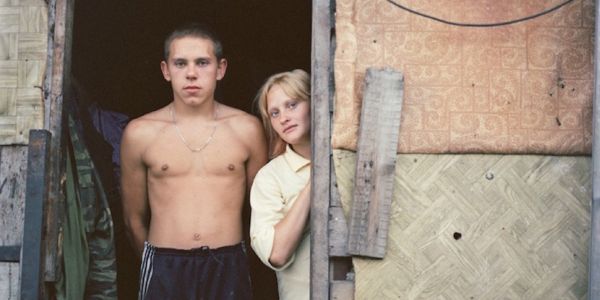SOMETHING BETTER TO COME: A Story Of A Phoenix Rising From The Trashes

Arlin is an all-around film person in Oakland, CA. He…
As bubbles fill the air surrounding world famous Red Square, and a young girl is seen relishing in their creation, one is likely to be filled with memories of their own bubble-oriented experiences of a normal, fondly recalled childhood, and imprint said associations onto the scene before them.
They would then immediately be rebuked for their premature assumptions, as we travel back with the child to her home, and it is revealed not to be a house, apartment, or even a tent on the street, but a shack built in the heart of a garbage dump. “I’m alive, I cant simply die and go away. It doesn’t work like that” the child’s mother later proclaims, as if to answer your unspoken question.
Something Better To Come takes place almost entirely in Svelka, the largest garbage dump in Europe, situated just 13 miles from the center of Moscow. The film takes for its subject young Yula, who lives in the dump with her mother and never stops thinking about the future.
“I want a normal life, not the one I have, which is not even close… I want to have a normal family and I want my mom to stop drinking” she explains early on. The film follows Yula and her cohorts at Svelka through adolescence and on into adulthood, in the process proving that no one’s fate is preordained, even if some are easier to predict.
You Don’t Miss What You Never Had
Though it’s clearly a nightmare in which to live, the dump also provides an endless playground for a group with children with active imaginations. A rusted out old car, and old boombox complete with American hip-hop cassettes, and even kittens are all provided by the dump, and for most of the children who have known no other life, the endless variety of Svelka is more than enough.
One small boy playing in a refuse pile exclaims “all you could ever want is here, with plenty for everyone” as he comes across an American flag and says proudly “a Russian flag!” This child is young, and therefore it can be implied that the dump is the only life he’s ever known. Yula, on the other hand, was forced into this situation with her parents after being kicked out of their subsidized apartment, so she has tasted existence beyond the edges of Svelka, and longs to return there.

Polak is open about “friendship” with her subjects from the get-go, and she refers to them as such. Filming covertly, against orders of security guards and even other dump-dwellers, her lens is both highly personal and absent of judgement. I can’t imagine the level of restraint required to stand by and watch kids playing in garbage and not acquiesce to the urge to intervene, but Polak’s level of participation always comes across as being just right; enough to prompt reflection and telling moments without ever unduly inserting herself into the scene.
Personally, as more and more documentarians feel compelled to place themselves in front of the camera and become a part of their narratives, I find this more restrained approach to be a refreshing return to form.
Playing Mother to Mom
As Yula ages, Polak continues to pay her visits at the dump; she finds that Yula has added liquor to the cigarettes she and her friends have been smoking non-stop since their youth, and even joins her mother in her daily ritual of drink. During these times she talks to Yula not with delicateness of a mother, for where is there room for the delicate in a dump, but rather with the tired laments of a life of regret one would expect from a morose drinking buddy.

For her and her daughter’s situation she blames Yula’s father, the police, Putin but never turns that analytical perspective back on herself in asking why they’ve remained here for years. But there is no need to protect Yula from the truth when her reality has been one of people getting run over by bulldozers or burned alive. Through all of this, though, Polak remarkably refrains from judgement and presents the scene as observationally as possible. This method pays off dividends in a heart-wrenching scene where Yula’s mother comes to her daughter seeking help, in a situation which is implied not to be unusual.
At age 16 and Yula finds part of her dream to have a come true; her and her mother no longer live in the dump. Their lives are only made nominally easier however, as their new home is with Yula’s alcoholic and abusive grandfather, and to make matters worse, Yula has found herself pregnant. Though a warmer shelter, this small home is in someways even less inviting than Svelka; Yula’s grandfather continually berates her and her mother and at one point even attacks Hanna Polak.

This new situation forces Yula to make some very tough decisions, shot expertly in way that recalled for me Lars Von Trier‘s dogme[expand]Dogme 95, the avant-garde filmmaking movement started in 1995 by filmmakers Lars Von Trier and Thomas Vinterberg, stipulated that films should be made based on the “traditional values of story, acting and theme”, and should exclude the use of special effects or technology. Its goal was to take away power from the studios and returning it to the artist. more[/expand] cinematography. Miles away from where she once played in piles of silver ribbon while bulldozer doused open flames with trash, Yula decision here represents a final departure from Svelka, as she is now compelled to take her life into her own hands.
Conclusion
On how they came to be in their current circumstances, Yula’s mother explains that her “father got arrested her for lack of id.” He was then held for a month and returned in such poor shape that he died a month later. This fits well with the Kafkaesque bureaucracy we in the west have inexorably attached to Russia, but it would be a mistake to come away from Something Better To Come with the impression that the film depicts a uniquely Russian problem.
The film brings to mind Lucy Walker‘s documentary Wasteland about a similar situation in Rio de Janeiro, but there are horror stories in the US as well of people jailed for petty or menial offenses who subsequently lose their jobs and homes during their time behind bars, sometimes just because they can’t afford to make bail. They then find themselves released as newly minted members of the homeless community. It is tempting to say “this is Putin’s Russia” but this reality exists all over the world.
One might not have much hope in coming out of a documentary about people living in such squalor that they hope to be drafted into the Russian army feeling uplifted, but Something Better To Come manages to achieve just that. Despite assault, substance abuse, disease, poverty and garbage fires, Yula manages to occupy the role her mother never could and lift them both out of destitution. But the film leaves us with visions of bubbles blowing and cats playing, implying that though trappings may vary throughout one’s life, who we are at our core seldom does.
Have you seen the film yet? Where does it rank for you on your list of documentaries dealing with homelessness?
Something Better To Come has been screened at many film festivals over the past year, and won 23 awards. It has been qualified to contend for the Academy Award in the Best Documentary Feature category in 2016. As of yet, there are no wide release dates scheduled. A Film Inquiry interview with director Hanna Polak is coming soon.
https://www.youtube.com/watch?v=9PereQR9lSk
(top image source: International Film Circuit)
Does content like this matter to you?
Become a Member and support film journalism. Unlock access to all of Film Inquiry`s great articles. Join a community of like-minded readers who are passionate about cinema - get access to our private members Network, give back to independent filmmakers, and more.
Arlin is an all-around film person in Oakland, CA. He received his BA in Film Studies in 2010, is a documentary distributor and filmmaker, and runs Drunken Film Fest Oakland. He rarely dreams, but the most frequent ones are the ones where it's finals and he hasn't been to class all semester. He hopes one day that the world recognizes the many values of the siesta system.













